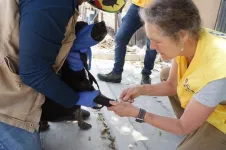(Press-News.org) Butterflies are disappearing in the United States. All kinds of them. With a speed scientists call alarming, and they are sounding an alarm.
A sweeping new study published in Science for the first time tallies butterfly data from more than 76,000 surveys across the continental United States. The results: between 2000 and 2020, total butterfly abundance fell by 22% across the 554 species counted. That means that for every five individual butterflies within the contiguous U.S. in the year 2000, there were only four in 2020.
“Action must be taken,” said Elise Zipkin, a Red Cedar Distinguished Professor of quantitative ecology at Michigan State University and a co-author of the paper. “To lose 22 percent of butterflies across the continental U.S. in just two decades is distressing and shows a clear need for broad-scale conservation interventions.”
Zipkin and her MSU colleague and co-author Nick Haddad, professor of integrative biology, have been major figures in drilling down the state of U.S. butterflies. Zipkin has been a formidable numbers cruncher with successes gleaning hard facts from imperfect data sets to better understand the natural world.
Haddad is a terrestrial ecologist – a scientist on the ground specializing in the fates of the most fragile and rare butterfly populations. The widespread decline of butterflies found in this study have shaken Haddad, and reports that the mountain of data is on display in his Michigan neighborhood.
“My neighbors notice it,” Haddad said. “Unprompted, they’ll say, ‘I’m seeing fewer butterflies in my garden, is that real?’ My neighbors are right. And it’s so shocking.”
In this paper, Zipkin and Haddad were among a working group of scientists with the USGS Powell Center for Analysis and Synthesis that aggregated decades of butterfly data from 35 monitor programs that included records of over 12.6 million butterflies. Using data integration approaches, the team examined how butterfly abundances changed regionally and individually for the 342 species with enough data.
Abundance is a term that threatens to become ironic. Butterfly populations dropped an average of 1.3% annually across the country, except for the Pacific Northwest. But even that encouraging result came with a caveat. Further scrutiny of the apparent 10% increase in overall abundance in the Pacific Northwest over the 20-year study period was credited largely to the California tortoiseshell butterfly, which was enjoying a population boom not expected to be sustained.
Butterflies are the most surveyed insect groups, courtesy of extensive volunteer-based and expert science monitoring programs. Until now, studies have focused on individual species – most notably monarch butterflies – or limited to specific locations.
This new study uses all the available regional butterfly monitoring data within the continental United States and then develops a method of analysis that appropriately accounts for variations in collection protocols across programs and regions to produce comparable results for hundreds of species.
“This is the definitive study of butterflies in the U.S.,” said Collin Edwards, the study’s lead author. “For those who were not already aware of insect declines, this should be a wake-up call. We urgently need both local- and national-scale conservation efforts to support butterflies and other insects. We have never had as clear and compelling a picture of butterfly declines as we do now.”
Edwards had been a postdoctoral research associate at Washington State University, Vancouver, and now works at the Washington Department of Fish and Wildlife.
The results reveal that 13 times as many species declined as increased – with 107 species losing more than half their populations.
Zipkin and Haddad say butterflies are more than fluttering symbols of freedom and beauty. They play important roles in cycling nutrients and are a significant food source for other organisms such as birds. Over the last 50 years, North America has lost nearly 3 billion birds, a decline at almost identical rates of the butterflies.
Butterflies are important and forgotten pollinators. People often think of bees first, but butterflies (and flies) are responsible for $120 million of cotton production in Texas, for example.
Zipkin said she sees this paper as an important heads up to the country’s policymakers. “People depend on plants, microbes, and animals for the air we breathe, the water we drink, and the food we eat. Yet, we are losing species at rates that rival the major mass extinction events on our planet,” Zipkin said. “The U.S. plays an important role in setting policies and creating laws that conserve and protect biodiversity from local to global scales. Our leaders and the federal government, in particular, are responsible for making sure future generations have the necessary resources to thrive.”
In 2024, Haddad was part of a study published by the journal PLOS ONE that pinpointed the danger of insecticides, that rose above other threats such as habitat loss and climate change in reducing butterfly abundance and diversity. He points out that saving butterflies isn’t a hopeless problem, just one that requires will.
A lot of insecticide use, he said, lacks strategy and results in overuse. Some 20 percent of cropland suffers from poor yields. Creating policies that return under-producing land to nature could help the butterflies to rally.
“Prophylactic and near-universal application of insecticides harms butterflies and other beneficial insects, with no proven benefit to crop yield,” Haddad said. “What is applied as ‘insurance’ is extracting a great debt to agroecosystems. The good news is that the widespread application of insecticides can be reversed, and butterflies and other pollinators will recover.”
In addition to Zipkin, Haddad, and Edwards, “Rapid butterfly declines across the United States during the 21st century” was written by Erica Henry, Matthew Forister, Kevin Burls, Steven Campbell, Elizabeth Crone, Jay Diffendorfer, Margaret Douglas, Ryan Drum, Candace Fallon, Jeffrey Glassberg, Eliza Grames, Rich Hatfield, Shiran Hershcovich, Scott Hoffman-Black, Elise Larsen, Wendy Leuenberger, Mary Linders, Travis Longcore, Daniel Marschalek, James Michielini, Naresh Neupane, Leslie Ries, Arthur Shapiro, Ann Swenger, Scott Swengel, Douglas Taron, Braeden Van Deynze, Jerome Wiedmann, Wayne Thogmartin, and Cheryl Schultz.
Zipkin and Haddad are members of MSU’s Ecology, Evolution, and Behavior Program, of which Zipkin is director.
END
Study raises the possibility of a country without butterflies
2025-03-06
ELSE PRESS RELEASES FROM THIS DATE:
Study reveals obesity gene in dogs that is relevant to human obesity studies
2025-03-06
Dogs are a compelling model of human obesity, in part because they develop obesity due to similar environmental influences as people. In a genome-wide association study (GWAS) of Labrador retrievers, researchers have identified an obesity-related gene – DENND1B – that may also influence obesity in humans. These findings highlight the value of using non-traditional animal models to study complex diseases and highlight the gene’s potential as a target for future obesity research across species. Obesity is a ...
A rapid decline in US butterfly populations
2025-03-06
Butterfly populations across the United States are in alarming decline, according to a new study, with total abundance falling by 22% in just 20 years. Such widespread and worrisome losses portend broader environmental threats and emphasize the urgent need for conservation action. “Our national-scale findings paint the most complete – and concerning – picture of the status of butterflies across the country in the early 21st century,” write the authors. The decline of biodiversity has been extensively documented worldwide. Among these losses, the decline of insects is particularly ...
Indigenous farming practices have shaped manioc’s genetic diversity for millennia
2025-03-06
A new genomic study reveals how Indigenous traditional farming practices have shaped the evolution of manioc – one of the world’s most important staple crops – for the better. The domestication of plants and the rise of agriculture were transformative events in human history. Today, a few staple crops provide most human calories, including manioc (cassava or yuca), a vital root crop that sustains nearly a billion people across the tropics. Although it ranks as the world’s seventh most significant crop, manioc is primarily cultivated on small farms. The plant’s ...
Controlling electrons in molecules at ultrafast timescales
2025-03-06
Scientists at YOKOHAMA National University, in collaboration with RIKEN and other institutions in Japan and Korea, have made an important discovery about how electrons move and behave in molecules. This discovery could potentially lead to advances in electronics, energy transfer, and chemical reactions. Published in the Journal, Science, their study reveals a new way to control the distribution of electrons in molecules using very fast phase-controlled pulses of light in the terahertz range.
Atoms and molecules contain negatively charged electrons that usually stay in specific energy levels, like layers, ...
Tropical forests in the Americas are struggling to keep pace with climate change
2025-03-06
Embargoed until 14:00 US Eastern Time, Thursday 6 March 2025
Tropical forests in the Americas are struggling to keep pace with climate change
Tropical rainforests play a vital role in global climate regulation and biodiversity conservation. However, a major new study published in Science reveals that forests across the Americas are not adapting quickly enough to keep pace with climate change, raising concerns about their long-term resilience.
The research, led by Dr. Jesús Aguirre-Gutiérrez from the University of Oxford’s Environmental Change Institute (ECI), involved over 100 scientists ...
Brain mapping unlocks key Alzheimer’s insights
2025-03-06
Researchers from The University of Texas at Arlington and the University of California–San Francisco have used a new brain-mapping technique to identify memory-related brain cells vulnerable to protein buildup, a key factor in the development of Alzheimer’s disease, an incurable, progressive brain disorder that slowly destroys memory and thinking skills.
In Texas, nearly half a million people live with Alzheimer’s disease, a form of dementia that costs the state approximately $24 billion in caregiver time, according to the Texas Department of State Health Services. Texas ranks fourth in the nation for Alzheimer’s cases ...
Clinical trial tests novel stem-cell treatment for Parkinson’s disease
2025-03-06
A recently launched Phase 1 clinical trial at Mass General Brigham is examining the safety and feasibility of a groundbreaking treatment approach for Parkinson’s disease in which a patient’s stem cells are reprogrammed to replace dopamine cells in the brain damaged by the disease. The first-of-its-kind trial of an autologous stem cell transplant, based on research and technologies invented and validated preclinically at McLean Hospital’s Neuroregeneration Research Institute (NRI), has enrolled and treated three patients at Brigham and Women’s ...
Awareness of rocky mountain spotted fever saves lives
2025-03-06
Rocky Mountain spotted fever is a bacterial infection spread by biting ticks to humans and dogs. Found on every continent except Antarctica, the infectious disease has been spreading since the early 2000s, most notably in Mexico and Brazil. Of the cases reported, more than half of infected people and dogs die.
A paper led by the University of California, Davis, highlights one of the most effective but often missing solutions to surviving this preventable, deadly disease: awareness. Most fatal cases stem from delays in diagnosis and treatment.
“The No. 1 thing that prevents human death from Rocky Mountain spotted fever is for everyone at high risk to know ...
Breakthrough in noninvasive monitoring of molecular processes in deep tissue
2025-03-06
The prestigious journal Advanced Materials recently published a groundbreaking study introducing a new method for monitoring molecular processes deep within tissue. Developed at the Technion - Israel Institute of Technology, the innovation is expected to accelerate key advancements in personalized medicine, cancer diagnosis, and early disease detection. The research was led by Prof. Hossam Haick, postdoctoral fellow Dr. Arnab Maity, and Ph.D. student Vivian Darsa Maidantchik from the Wolfson Faculty of Chemical Engineering at the Technion. The study also involved Dr. Dalit Barkan, research assistant Dr. Keren ...
BU researcher named rising star in endocrinology
2025-03-06
(Boston)—Sun Lee, MD, MSc, assistant professor of medicine at Boston University Chobanian & Avedisian School of Medicine, has been awarded an American Association of Clinical Endocrinology (AACE) Rising Star in Endocrinology Award.
The honor is presented to a physician who is within 10 years of completing their endocrine fellowship and has demonstrated actionable outcomes in outstanding leadership, teamwork and/or innovation in support of AACE’s mission to elevate clinical endocrinology ...




